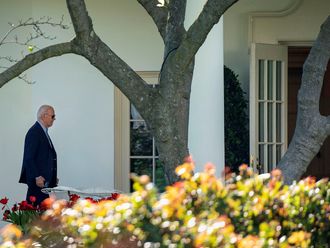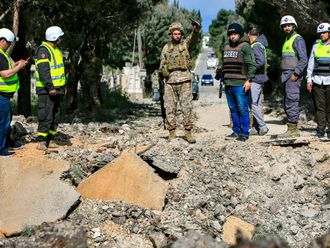NEW YORK: Thousands of anti-corporate demonstrators and union members poured through New York's financial district Wednesday to protest inequality in the US economy.
The ranks of the more than two weeks-long sit-in protest in New York swelled hugely ahead of the start of the march as US labor unions lent their powerful voice to the movement, watched by large numbers of police.
Crowds banging drums and carrying signs like "Save our Republic" and "Equality, democracy, revolution," crammed into the narrow, teeming streets near Wall Street, symbolic headquarters of the US corporate world.
Chanting "this is what democracy looks like" and "we are 99 percent," the loosely woven coalition of protesters was now backed by major unions including the AFL-CIO, United Auto Workers and Transit Workers Union.
The sheer numbers meant that protestors, who have marched daily into Wall Street and other nearby symbols of corporate power, were likely to flood the busy, narrow streets.
"More numbers, more power, more publicity," said Kelly Wells, 26, who said she came all the way from Oregon to join the peaceful street rebellion.
Protestors have a huge list of grievances, ranging from the mountain of US student debt to shrinking retirement benefits for the elderly, as the United States struggles to regain its once powerful economic stride.
"The way our society is now headed it does not work for 99 percent of people," said Michael Mulgrew, president of the United Federation of Teachers, who expressed support and pride for the mostly-young demonstrators.
"They've been able to create a national conversation that we think should have been going on for years," said Mulgrew, whose union is one of several which have signed on to the demonstrations, now in their third week.
The protestors' main anger is directed at corporate influence in politics and the government bailout in 2008 and it comes against a backdrop of dismay at the lack of leadership from either President Barack Obama's Democrats or the opposition Republicans a year from a presidential election.
"I think everyone out here feels robbed. They are struggling to make a living, to keep a roof over their heads, they're struggling to pay student loans," Lindsey Personette, a 29-year-old dancer, said.
"This is a revolution. This is not going to go away. It's only going to get bigger."
As the protests - ignored initially by much of the media - grabbed growing attention, New York's liberal congresswoman, Louise Slaughter, gave the demonstrations her blessing.
"I'm so proud to see the Occupy Wall Street movement standing up to this rampant corporate greed and peacefully participating in our democracy," she said in a statement.
Also joining the protest movement were students, who, according to the Occupywallst.org website were staging a national walkout.
The march was backed by members of the United Federation of Teachers, which represents most of New York's public school teachers, as well as the Workers United and Transport Workers, which represents many of the city's bus drivers.
The Professional Staff Congress-CUNY (PSC-CUNY), which represents more than 20,000 professors and staff at the City University of New York, also gave its support.
The movement has had widening support, with franchises popping up in towns and major cities across the United States, leading some political observers to liken it to a left-wing version of the populist conservative Tea Party movement.
Small anti-Wall Street demos have cropped up in Boston, Chicago, Los Angeles and elsewhere.
The new protest comes four days after more than 700 protesters were arrested on the Brooklyn Bridge when they defied police and stalled traffic.
Police said most of those arrested were issued criminal court summons and citations for disorderly conduct before being released later in the day.












